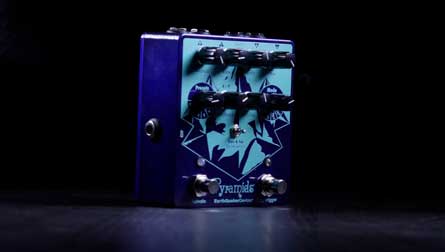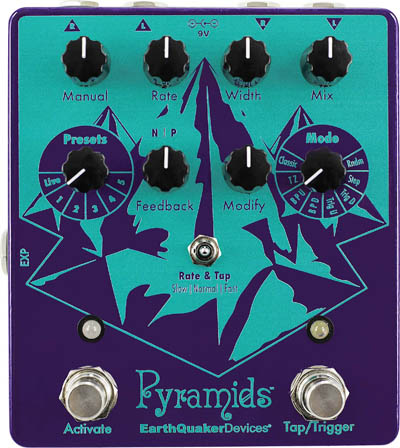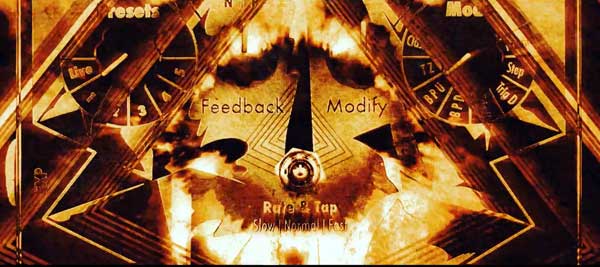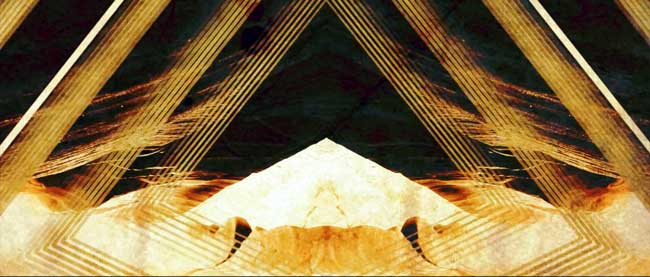EarthQuaker Devices recently unveiled a new stereo flanger pedal dubbed “Pyramids” – and what a pedal it is! Admittedly, my experience with true stereo flanging pedals was minimal, so I delved into this pedal with a healthy dose of extra curiosity. It paid off, as this particular pedal was versatile as a normal run-of-the-mill flanger, but contained several alternate modes that ranged from downright fun, to bizarre, and everything in-between.
Take for instance, the aptly named Classic mode, which, as expected is modeled after historic flanging units and contains an even and rich sweep across the frequency spectrum in both directions. This would be the mode to use for anyone desiring a great usable flanger mode, but more tailored and focused with fewer audible artifacts or excess tonal coloration like some flangers are guilty of producing.
Of course, since this is EQD we are talking about, the Feedback and Modify controls can push this mode into exaggerated territory that goes well beyond standard flangers. To illustrate the other Mode settings, I’d like to describe how they were incorporated into the various tracks of my audio mix, as heard on our demo video above. An interesting fact is that I was able to record all of the tracks with this flanger (besides one drum section and the violins). With some selective listening of the track, you can specifically hear how each flanger type operates and colors your signal.
Our Video – The Drum Sounds
 The score that I composed for the demo contained an underlying component, a heartbeat pulse, that was made with a bass drum sound. I re-amped the track with the Trigger Up mode, which caused a very slight and almost imperceptible tonal sweep throughout the track. The flanger’s doubling effect really added extra body to the bass drum and hyped my track up quite nicely. After that, I used sidechain compression on the bass guitar track and bussed the bass drum into it to create a nice pulsing effect, essentially dipping the bass track to leave room for the drums to be heard. There are a few moments where the drum is exposed clearly and you can hear the effects that I’m speaking of.
The score that I composed for the demo contained an underlying component, a heartbeat pulse, that was made with a bass drum sound. I re-amped the track with the Trigger Up mode, which caused a very slight and almost imperceptible tonal sweep throughout the track. The flanger’s doubling effect really added extra body to the bass drum and hyped my track up quite nicely. After that, I used sidechain compression on the bass guitar track and bussed the bass drum into it to create a nice pulsing effect, essentially dipping the bass track to leave room for the drums to be heard. There are a few moments where the drum is exposed clearly and you can hear the effects that I’m speaking of.
Next came the cymbals, which sounded just fine on their own in my mix, but I got curious as to how they would interact while re-amped through the Pyramids pedal. Sure enough, they took on new life! The Trigger Down mode sounded best for preserving a lot of the initial crisp attack of the cymbal. On top of that, the downward modulation of the flanger created a sort of warped decay effect. There are plenty of moments of dead space within the cymbal tracks, so setting the Feedback control past noon introduced more positive feedback. This created a heavy type of “whooshing” sound that offered lots of depth to the cymbal sounds while they were slowly decaying.
The Guitar Sounds
For my track’s underlying sound bed, I wanted there to be very little harmony in order to create the effect of space or stagnation, allowing the sounds above them to be the main focus. That being said, I didn’t want them to be fully ignored either. The solution? Add a more subtle flavor of flanger to the tracks, which in this case was the Classic mode on the Slow setting. By utilizing a slower sweep, the phasing issues were minimized. The Width and Feedback knobs were lowered a bit to also not have too intense of a “swoosh” sound I mentioned earlier. I hard-panned each of them left and right to keep them in the background, and they worked well for giving some extra depth to the overall score.
Next up were my guitar tracks, which I dubbed “Spacey Leads” – they were the spooky sounding background guitar parts that featured lots of dissonant harmonies like the Min(b5), or the MinMaj9(b5). These were merely tension chords, so I wanted a flanger that would enhance them. I settled upon the Through-Zero mode because this type of flanging effect has a 180-degree, out-of-phase moment (when the “zero-point” crossover happens) where the two signals cancel each other out, creating a short moment of no sound. With these chords, it made them feel as if they were disappearing and reappearing at the different points of the phasing. They were some of the most eerie parts of the track overall, and if you need a reference, they can be heard clearly during the first few seconds of the video.
Later on in the score, the video’s voiceover calls out the remaining few modes that weren’t already discussed here. In order, they were the Step and Random modes. The Step mode sweeps up and down in increments or “steps”, sort of similar to the effect heard on synthesizer sequencers. When the pedal is engaged in this mode, the Modify control then adjusts the glide between the steps either starkly, or more smoothly and glissando-like. The Random function is impossible to describe, as it is the Step mode but the sweep and glide are randomized with no type of pattern or order. It was truly something wild to hear, almost like a glitch!
The Voiceover
The voiceover, while admittedly a bit unsettling, was also a prime candidate for adding the flanger effect. I wanted to mostly enhance the track, rather than outright saturate it in modulation, so I opted for the Classic mode, with the Mix, Width, and Rate controls all set fairly low. In fact, engineers have similarly used light flanging effects via tape to “thicken” the perceived body of singers’ vocal tracks for decades. The reason being that flanger creates a copy of the source signal and slightly delays one of them, increasing the amplitude and lending more depth. In my own track, it certainly accomplished that very same thing.
The Bass Tracks
The Pyramids also proved to be a wonderful tool for electric bass tracks too, which comes as no surprise because of the signal doubling effect I had mentioned earlier. Be careful though — the boost in low frequencies can cause resonance problems, but a simple tweak of the Width knobs (among others) can usually tame that problem a bit. As for the specific setting I chose, I settled upon the Barber Pole Down made for a chorus-like sound that worked quite well for super thick tones. Feel free to experiment with other settings though, because most of them still work well for bass and deserve some exploration too.
This was one cool pedal, with nearly infinite possibilities for both tweaking or for usage on other instruments besides guitar/bass/and drums as was heard here on our demo. I didn’t discuss the stereo possibilities of the pedal specifically, but I used this function on all of the tracks of my mix and had fun splitting the stereo outputs. The interesting panning techniques I was then able to utilize certainly enhanced its versatility and offered up some awesome tonal colors. As you can see, the Pyramids undeniably affords plenty of options for the curious pedal lovers out there, so check one out!





